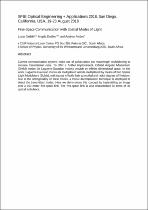JavaScript is disabled for your browser. Some features of this site may not work without it.
- ResearchSpace
- →
- Research Publications/Outputs
- →
- Conference Publications
- →
- View Item
| dc.contributor.author |
Gailele, Lucas M

|
|
| dc.contributor.author |
Dudley, Angela L

|
|
| dc.contributor.author |
Forbes, A

|
|
| dc.date.accessioned | 2018-11-30T06:38:36Z | |
| dc.date.available | 2018-11-30T06:38:36Z | |
| dc.date.issued | 2018-09 | |
| dc.identifier.citation | Gailele, L.M., Dudley, A.L. and Forbes, A. 2018. Free-space communication with spatial modes of light. In: SPIE Optical Engineering + Applications 2018, 19 - 23 August 2018, San Diego, California, USA | en_US |
| dc.identifier.issn | 0277-786X | |
| dc.identifier.uri | https://spie.org/Publications/Proceedings/Paper/10.1117/12.2505725 | |
| dc.identifier.uri | http://hdl.handle.net/10204/10560 | |
| dc.description | Presented at: SPIE Optical Engineering + Applications 2018, San Diego, California, USA, 19-23 August 2018. Due to copyright restrictions, the attached PDF file only contains the abstract of the full-text item. For access to the full-text item, please consult the publisher's website. | en_US |
| dc.description.abstract | Current communication systems make use of polarization and wavelength multiplexing to increase transmission rates. To offer a further improvement, Orbital Angular Momentum (OAM) modes (or Laguerre-Gaussian modes) provide an infinite dimensional space. In this work, Laguerre-Gaussian modes are multiplexed and de-multiplexed by means of two Spatial Light Modulators (SLMs), making use of both their azimuthal and radial degrees of freedom. Due to the orthogonality of these modes, a modal decomposition technique is employed to detect the transmitted modes. Here we demonstrate this concept by transmitting an image over a 150 meter free-space link. The free-space link is also characterized in terms of its optical turbulence. | en_US |
| dc.language.iso | en | en_US |
| dc.publisher | SPIE | en_US |
| dc.relation.ispartofseries | Workflow;21386 | |
| dc.subject | Azimuthal and radial degrees of freedom | en_US |
| dc.subject | Free-space communication | en_US |
| dc.subject | Laguerre-Gaussian modes | en_US |
| dc.subject | Multiplexing | en_US |
| dc.subject | Orbital angular momentum | en_US |
| dc.subject | OAM | en_US |
| dc.subject | Spatial light modulator | en_US |
| dc.title | Free-space communication with spatial modes of light | en_US |
| dc.type | Conference Presentation | en_US |
| dc.identifier.apacitation | Gailele, L. M., Dudley, A. L., & Forbes, A. (2018). Free-space communication with spatial modes of light. SPIE. http://hdl.handle.net/10204/10560 | en_ZA |
| dc.identifier.chicagocitation | Gailele, Lucas M, Angela L Dudley, and A Forbes. "Free-space communication with spatial modes of light." (2018): http://hdl.handle.net/10204/10560 | en_ZA |
| dc.identifier.vancouvercitation | Gailele LM, Dudley AL, Forbes A, Free-space communication with spatial modes of light; SPIE; 2018. http://hdl.handle.net/10204/10560 . | en_ZA |
| dc.identifier.ris | TY - Conference Presentation AU - Gailele, Lucas M AU - Dudley, Angela L AU - Forbes, A AB - Current communication systems make use of polarization and wavelength multiplexing to increase transmission rates. To offer a further improvement, Orbital Angular Momentum (OAM) modes (or Laguerre-Gaussian modes) provide an infinite dimensional space. In this work, Laguerre-Gaussian modes are multiplexed and de-multiplexed by means of two Spatial Light Modulators (SLMs), making use of both their azimuthal and radial degrees of freedom. Due to the orthogonality of these modes, a modal decomposition technique is employed to detect the transmitted modes. Here we demonstrate this concept by transmitting an image over a 150 meter free-space link. The free-space link is also characterized in terms of its optical turbulence. DA - 2018-09 DB - ResearchSpace DP - CSIR KW - Azimuthal and radial degrees of freedom KW - Free-space communication KW - Laguerre-Gaussian modes KW - Multiplexing KW - Orbital angular momentum KW - OAM KW - Spatial light modulator LK - https://researchspace.csir.co.za PY - 2018 SM - 0277-786X T1 - Free-space communication with spatial modes of light TI - Free-space communication with spatial modes of light UR - http://hdl.handle.net/10204/10560 ER - | en_ZA |






